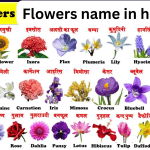Flowers, those exquisite manifestations of nature’s beauty, have captivated humans for centuries. Their vibrant colors, delicate petals, and enchanting fragrances evoke feelings of joy, love, and tranquility. In this comprehensive guide, we delve into the enchanting world of Flowers Name in Hindi, unraveling the mysteries behind their names and celebrating their cultural significance.
Best Flowers Name in Hindi
पुष्पों की खूबसूरती दुनिया (Pushpo Ki Khoobsurti Duniya) – The Beautiful World of Flowers
Flowers are nature’s way of adding a splash of color and fragrance to our world. They come in a wide variety of shapes, sizes, and colors, each with its own unique beauty. In India, flowers have a special place in our culture and traditions. They are used in festivals, religious ceremonies, and as everyday offerings. Here are 50 names of flowers in Hindi to introduce you to this vibrant world:
- गुलाब (Gulab) – Rose
- कमल (Kamal) – Lotus
- चमेली (Chambeli) – Jasmine
- गेंदा (Genda) – Marigold
- मोगरा (Mogra) – Mogra
- जैस्मीन (Jasmin) – Jasmine
- रजनीगंधा (Rajnigandha) – Night-queen Jasmine
- आर्किड (Arkid) – Orchid
- ट्यूलिप (Tyulip) – Tulip
- गुड़हल (Gurhal) – China Rose
- सूरजमुखी (Surajmukhi) – Sunflower
- गुलमोहर (Gulmohar) – Flamboyant
- अशोक (Ashok) – Ashok Tree
- पलाश (Palash) – Butea monosperma
- कनेर (Kaner) – Yellow Oleander
- चंपा (Champa) – Champaca
- सेवंती (Sevanti) – White Ixora
- जवाकुसुम (Jawakusum) – Shoe Flower
- बेल (Bel) – Wood Apple Tree
- आक (Aak) – Milkweed
- कदंब (Kadamb) – Kadamba
- मന്殊आ (Manshua) – Indian Coral Tree
- सहजन (Sahajan) – Moringa
- मदार (Madar) – Milkweed
- धतूरा (Dhatura) – Datura
- कैक्टस (Cactus) – Cactus
- बोगनविलिया (Bougainvillea) – Bougainvillea
- हाइबस्कस (Hibiscus) – Hibiscus
- पैंसे (Pansies) – Pansy
- डहलिया (Dahlia) – Dahlia
- लिली (Lily) – Lily
- आइरिस (Iris) – Iris
- ऑर्किड (Orchid) – Orchid
- डेज़ी (Daisy) – Daisy
- ट्यूलिप (Tulip) – Tulip
- नार्सिसस (Narcissus) – Daffodil
- 弗里西亚 (Freesia) – Freesia
- लैवेंडर (Lavender) – Lavender
- जर्बेरा (Gerbera) – Gerbera Daisy
- लिली ऑफ द वैली (Lily of the Valley) – Lily of the Valley
- हनीसकल (Honeysuckle) – Honeysuckle
- पियोना (Peony) – Peony
- बटरकप (Buttercup) – Buttercup
- डैफोडिल (Daffodil) – Daffodil
- हयासिंथ (Hyacinth) – Hyacinth
- गजरा (Gajra) – A hair ornament made with flowers
- जूही (Juhi) – Indian Jasmine
- पारिजात (Parijat) – Night Jasmine
- संपुष्प (Sampushpa) – Cluster flower
- कमलक (Kamalkak) – Lotus bud
Best and Favorite Flowers names in Hindi
Here are some popular flowers along with their names in both Hindi and English:
- Rose (गुलाब – Gulab)
- Jasmine (मोगरा – Mogra)
- Lotus (कमल – Kamal)
- Marigold (गेंदा – Genda)
- Sunflower (सूरजमुखी – Surajmukhi)
- Lily (कुमुदिनी – Kumudini)
- Orchid (ऑर्किड – Orchid)
- Tulip (तुलिप – Tulip)
- Daisy (डेजी – Daisy)
- Chrysanthemum (गुलदाउदी – Guldawdi)
These are just a few examples, and there are many more beautiful flowers with delightful names in both languages.
CHECK THIS MORE:
https://hindijankaree.com/well-health-tips-in-hindi-wellhealthorganic
Indian flowers name
India, a land of vibrant colors and diverse landscapes, boasts a rich variety of flowers. Here are some of the most popular ones:
Lotus (Kamal): The national flower of India, the lotus holds a special place in Hinduism and is considered a symbol of purity, enlightenment, and spiritual growth. Lotus flower Indiapen_spark
Jasmine (Champa): Known for its intoxicating fragrance, jasmine is widely used in Indian weddings and festivals. It is also believed to have calming and stress-relieving properties. Jasmine flower India
Marigold (Genda): Available in vibrant shades of orange, yellow, and red, marigolds are considered auspicious flowers in India. They are used in religious ceremonies, decoration, and even in some culinary preparations. Marigold flower India
Rose (Gulab): A universal symbol of love, the rose is popular in India as well. It is grown in a variety of colors and is used for gifting, decoration, and in the production of perfumes and essential oils. Rose flower India
Hibiscus (Jaswand): These large, trumpet-shaped flowers come in a range of colors, including red, yellow, orange, and pink. Hibiscus flowers are not only beautiful but also have medicinal properties. The tea made from dried hibiscus flowers is believed to have various health benefits. Hibiscus flower India
Plumeria (Champa): Also known as frangipani, plumeria is a beautiful flowering tree native to the tropical regions of America. It has white, yellow, or pink flowers with a strong, sweet fragrance. Plumeria flowers are commonly used in religious ceremonies and for making garlands. Plumeria flower India
Indian Coral Tree (Kanchanar): This flamboyant tree is known for its clusters of bright orange or red flowers. It is a popular ornamental plant and is also considered to have medicinal properties. Indian Coral Tree flower India
Canna Lily (Ketaki): With its large, showy flowers in various colors, the canna lily is a popular choice for gardens. It is a low-maintenance plant that thrives in warm climates. Canna Lily flower India
Night-queen (Raatrani): As the name suggests, this flower blooms at night, releasing a powerful and sweet fragrance. It is believed to have a calming effect and is often used in aromatherapy. Nightqueen flower India
Gulmohar (Gulmohr): Also known as the Flame of the Forest, gulmohar is a large tree with clusters of bright orange flowers. It is a common sight in Indian cities and towns and adds a pop of color to the landscape during its flowering season.
100 flower names
- Rose
- Tulip
- Lily
- Daisy
- Orchid
- Sunflower
- Marigold
- Carnation
- Peony
- Hyacinth
- Dahlia
- Iris
- Poppy
- Gerbera
- Lavender
- Jasmine
- Chrysanthemum
- Zinnia
- Snapdragon
- Aster
- Gladiolus
- Daffodil
- Hibiscus
- Geranium
- Bluebell
- Forget-me-not
- Cosmos
- Anemone
- Ranunculus
- Freesia
- Calla Lily
- Magnolia
- Foxglove
- Bleeding Heart
- Lily of the Valley
- Sweet Pea
- Canterbury Bells
- Columbine
- Coneflower
- Gazania
- Iceland Poppy
- Nigella
- Queen Anne’s Lace
- Pansy
- Ranunculus
- Statice
- Stock
- Snowdrop
- Wisteria
- Yarrow
- Alstroemeria
- Baby’s Breath
- Bellflower
- Black-eyed Susan
- Bougainvillea
- Camellia
- Celosia
- Cornflower
- Crocus
- Dianthus
- Echinacea
- Evening Primrose
- Fuchsia
- Gentian
- Gloriosa Lily
- Hellebore
- Honeysuckle
- Kangaroo Paw
- Lisianthus
- Morning Glory
- Oleander
- Peacock Orchid
- Periwinkle
- Primrose
- Protea
- Queen of the Night
- Rhododendron
- Rudbeckia
- Salvia
- Spider Lily
- Starflower
- Stephanotis
- Sweet William
- Tansy
- Thistle
- Tiger Lily
- Trillium
- Verbena
- Violet
- Wallflower
- Waxflower
- Winter Jasmine
- Wood Anemone
- Yarrow
- Yucca
- Zantedeschia (Calla Lily)
- Zea mays (Cornflower)
- Zephyranthes (Rain Lily)
- Zinnia
- Zantedeschia (Calla Lily)
The Cultural Tapestry of Hindi Flower Names
Rose (गुलाब)
The Rose, known as Gulab in Hindi, holds a special place in various cultures worldwide. Revered for its timeless elegance and intoxicating scent, the Rose symbolizes love, passion, and purity. In Hindi poetry and literature, the Rose is often used as a metaphor for beauty and romance, enriching the language with its allure.
Marigold (गेंदा)
Marigold, or Genda in Hindi, is a symbol of auspiciousness and prosperity. Adorning festive occasions and religious ceremonies, the Marigold’s vibrant hues of yellow and orange infuse joy and vitality into cultural celebrations across India. Its significance extends beyond mere aesthetics, embodying optimism and good fortune.
Lotus (कमल)
The Lotus, known as Kamal in Hindi, is revered as a sacred flower with profound spiritual symbolism. Rising gracefully from muddy waters to blossom into pristine beauty, the Lotus represents purity, enlightenment, and rebirth. It holds immense significance in Hinduism, Buddhism, and Jainism, where it symbolizes spiritual awakening and divine transformation.
Jasmine (चमेली)
Jasmine, or Chameli in Hindi, exudes a heavenly fragrance that captivates the senses. Revered for its delicate white blossoms and intoxicating aroma, Jasmine holds cultural significance in weddings, religious rituals, and traditional medicine. Its presence in gardens and homes symbolizes purity, sensuality, and eternal love.
Sunflower (सूरजमुखी)
Sunflower, or Surajmukhi in Hindi, epitomizes vitality, resilience, and optimism. With its radiant yellow petals following the sun’s path, the Sunflower symbolizes warmth, happiness, and positivity. In Hindi folklore, the Sunflower’s vibrant presence is associated with vitality and the triumph of light over darkness.
The Language of Flowers: Communicating Emotions
In addition to their aesthetic appeal, Flowers Name in Hindi convey a rich tapestry of emotions, each bloom possessing its unique symbolism:
- Red Roses (लाल गुलाब): Symbolize passionate love and desire.
- White Lotus (सफेद कमल): Signify purity, enlightenment, and spiritual growth.
- Yellow Marigolds (पीले गेंदा): Represent prosperity, optimism, and joyous celebrations.
- Orange Jasmine (नारंगी चमेली): Convey enthusiasm, energy, and vitality.
- Golden Sunflowers (सोने का सूरजमुखी): Reflect abundance, vitality, and radiant positivity.
FAQS
1. What is the Hindi name for the flower commonly known as “Rose”?
The Hindi name for the flower “Rose” is “Gulab” (गुलाब).
2. How do you say “Sunflower” in Hindi?
“Sunflower” in Hindi is called “Surajmukhi” (सूरजमुखी).
3. What is the Hindi term for the flower known as “Jasmine”?
The Hindi name for “Jasmine” is “Chameli” (चमेली).
4. How do you refer to “Lily” in Hindi?
“Lily” in Hindi is called “Kamal” (कमल).
5. What is the Hindi name for the flower commonly known as “Marigold”?
The Hindi term for “Marigold” is “Genda” (गेंदा).
Conclusion
In conclusion, Flowers Name in Hindi offers a glimpse into the rich cultural heritage and profound symbolism embedded within each blossom. From the timeless elegance of Roses to the spiritual profundity of Lotuses, these flowers transcend mere botanical specimens, embodying emotions, traditions, and aspirations. By embracing the beauty of Hindi flower names, we embark on a journey of discovery, connecting with nature’s splendor and the depths of human emotion.










